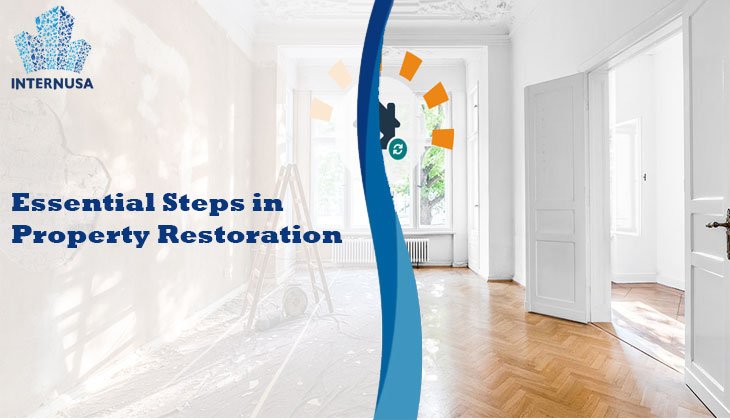Essential Steps in Property Restoration
Disasters strike without warning, leaving behind significant damage to homes and commercial properties. Whether it’s due to fire, flood, mold, or storms, property restoration services play a critical role in returning your space to its pre-loss condition. This guide explains the essentials of property restoration, from emergency response to full reconstruction.
What Is Property Restoration?
Property restoration refers to the process of repairing, cleaning, and rebuilding structures after damage from water, fire, mold, storms, or vandalism. It involves specialized techniques to:
- Remove contaminants
- Dry waterlogged areas
- Eliminate smoke and soot damage
- Rebuild damaged walls, floors, and ceilings
The goal is not just cosmetic repairs, but restoring the safety, integrity, and livability of a property.
Common Types of Property Damage
1. Water Damage
Leaking pipes, storms, or burst plumbing can cause significant damage. Restoration includes water extraction, drying, dehumidifying, and mold prevention.
2. Fire and Smoke Damage
Beyond burned materials, smoke and soot can penetrate walls, furniture, and ductwork. Restoration involves deep cleaning, deodorizing, and structural repair.
3. Mold Infestation
Mold thrives in damp environments and can be hazardous to health. Restoration includes mold removal, air quality testing, and addressing moisture sources.
4. Storm and Wind Damage
Storms can lead to broken windows, damaged roofs, and flooding. Restoration includes emergency board-ups, roof tarping, and debris cleanup.
5. Vandalism and Accidental Damage
Broken glass, graffiti, or unauthorized entry can compromise a property’s safety. Restoration may involve security improvements, repainting, and repair work.
The Property Restoration Process
Step 1: Emergency Response
Many restoration companies offer 24/7 emergency services. Quick action minimizes damage and speeds up recovery.
Step 2: Damage Assessment
Professionals inspect the site to determine the extent of damage and develop a custom restoration plan.
Step 3: Mitigation
This step prevents further damage. It includes boarding up windows, drying wet areas, or removing hazardous materials.
Step 4: Restoration and Repairs
This is where the property is rebuilt, painted, re-floored, and cleaned until it resembles its original condition.
Step 5: Final Inspection
A final walkthrough ensures all work is completed, and the property is safe for use.
Choosing the Right Property Restoration Company
When selecting a provider, look for:
- 24/7 emergency availability
- IICRC certification (Institute of Inspection Cleaning and Restoration Certification)
- Experience with your type of property damage
- Transparent pricing and insurance coordination
Read online reviews, check credentials, and ensure they use modern equipment and techniques.
Insurance and Restoration
In most cases, property restoration is covered by homeowner’s insurance. Restoration experts often help communicate with insurers by:
- Documenting damage with photos and reports
- Estimating restoration costs
- Negotiating with adjusters
Commercial Property Restoration
Businesses also benefit from fast and professional restoration services. Whether it’s a warehouse, retail space, or office building, commercial property restoration aims to:
- Minimize downtime
- Restore operations quickly
- Ensure health and safety compliance
Professional teams may use large-scale drying equipment and offer flexible scheduling to reduce disruption.
Post-Restoration Tips for Property Owners
- Test all utilities before regular use
- Keep copies of restoration and insurance documents
- Schedule routine inspections for mold or leaks
- Consider upgrades during repairs (e.g., better insulation, storm-resistant windows)
FAQs About Property Restoration
Q: How long does property restoration take? A: It depends on the damage type and extent. Minor water damage might take a few days, while major fire restoration could take weeks.
Q: Will my insurance cover all restoration costs? A: Most homeowner’s insurance policies cover restoration, but always check your coverage details and deductibles.
Q: Is mold removal included in water damage restoration? A: Yes, mold prevention and removal are usually part of comprehensive water damage services.
Q: Can I stay in my home during restoration? A: It depends on the severity of damage. For minor work, staying may be safe, but large restorations often require temporary relocation.
Why Timely Restoration Matters
Delaying restoration can lead to:
- Structural damage
- Mold growth
- Higher repair costs
- Health risks from smoke or contaminated water
Acting quickly protects both your investment and your family’s well-being.
Property restoration is more than just a repair job—it’s a pathway to normalcy after unexpected events. Whether you’re dealing with fire, flood, or mold, working with skilled restoration professionals ensures your property is restored efficiently and safely.







